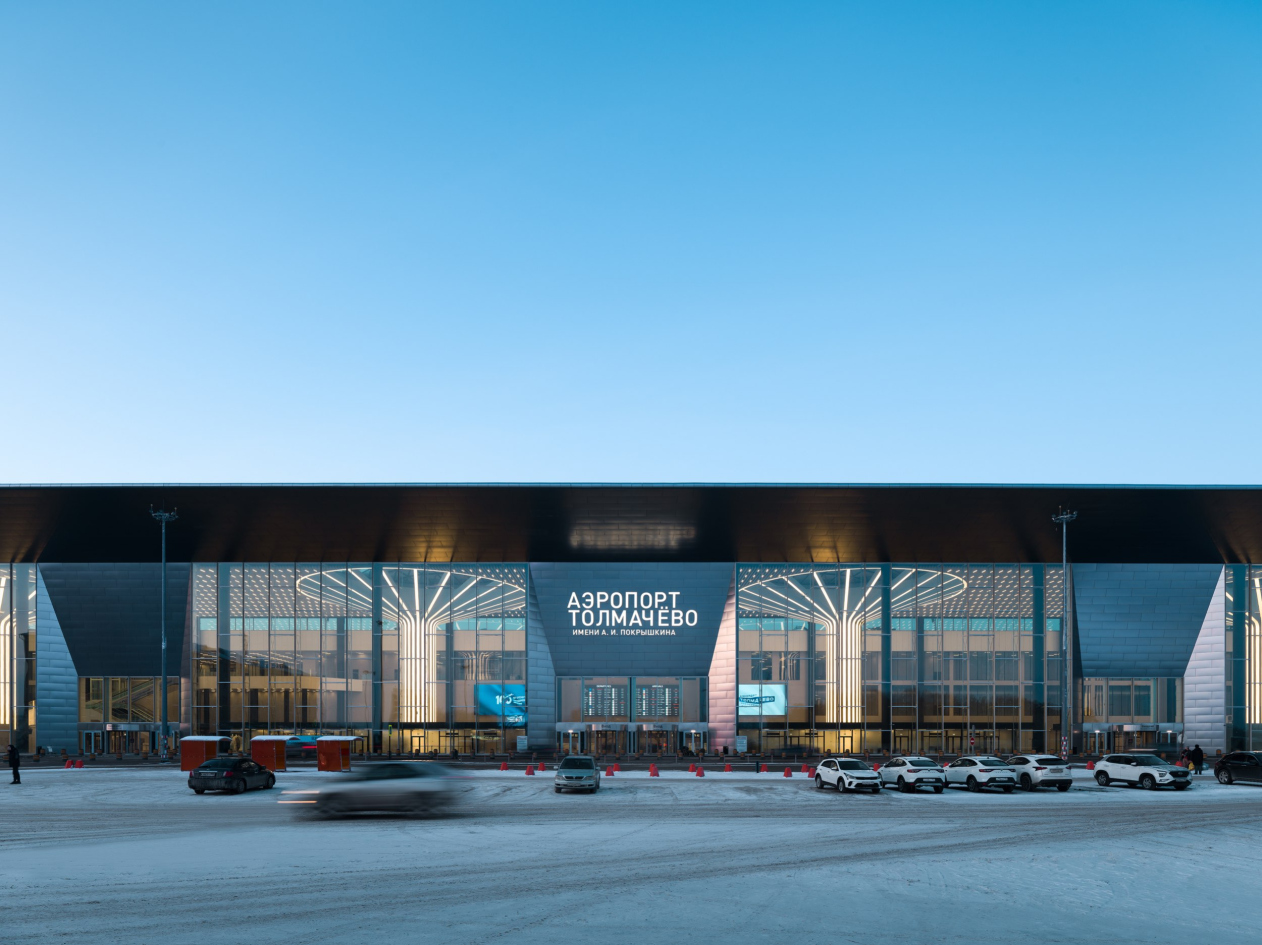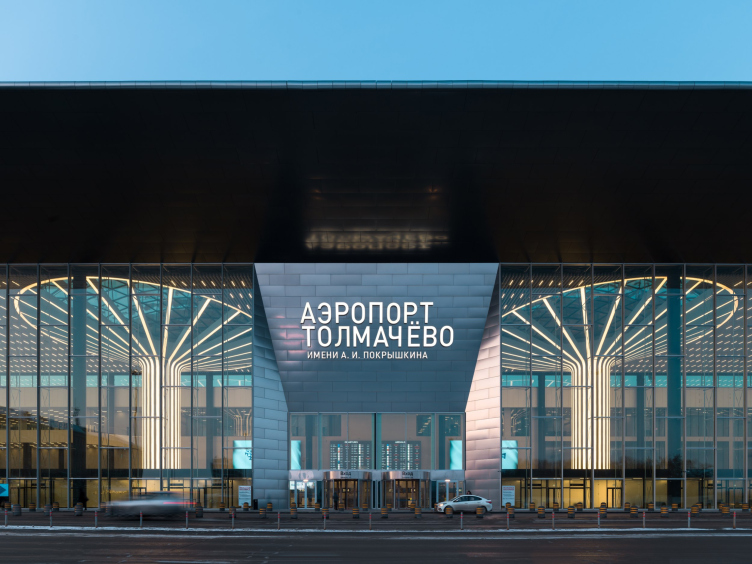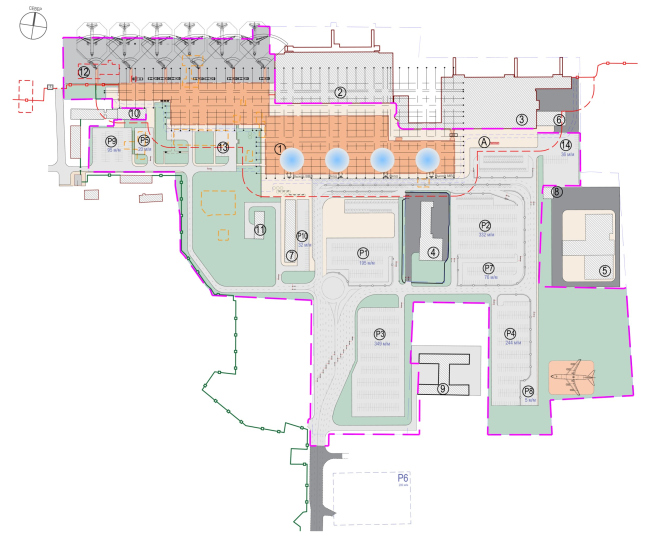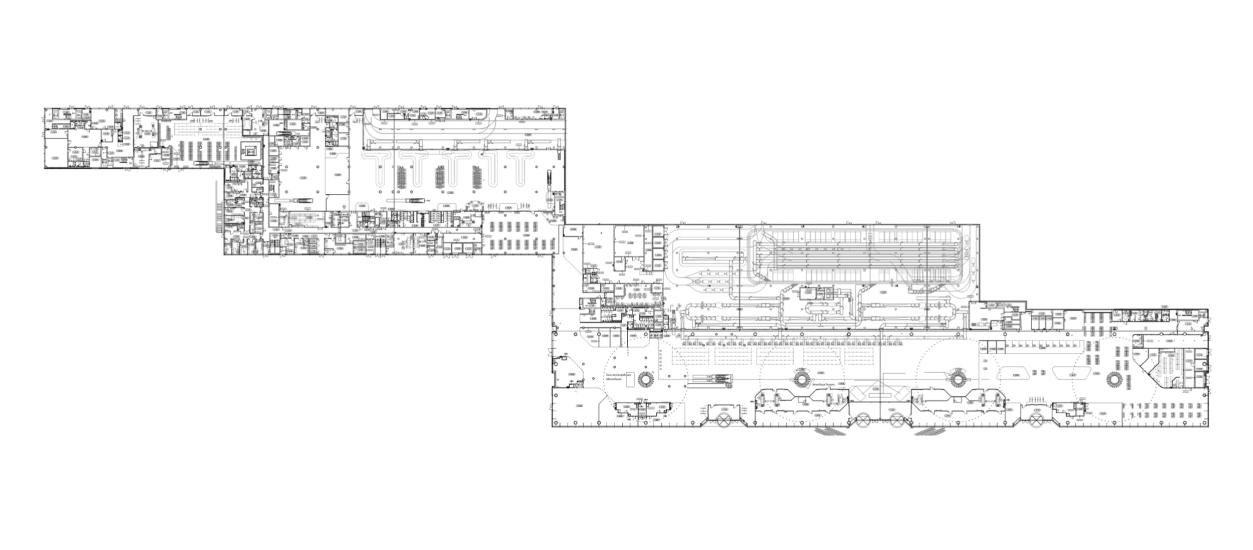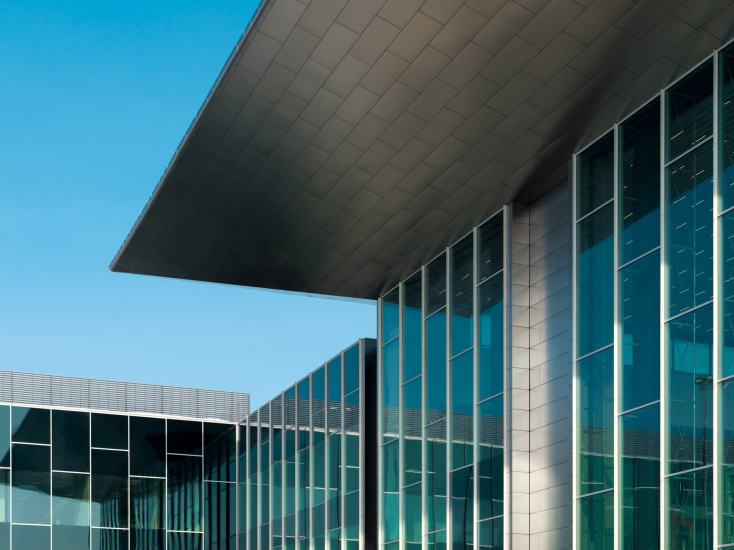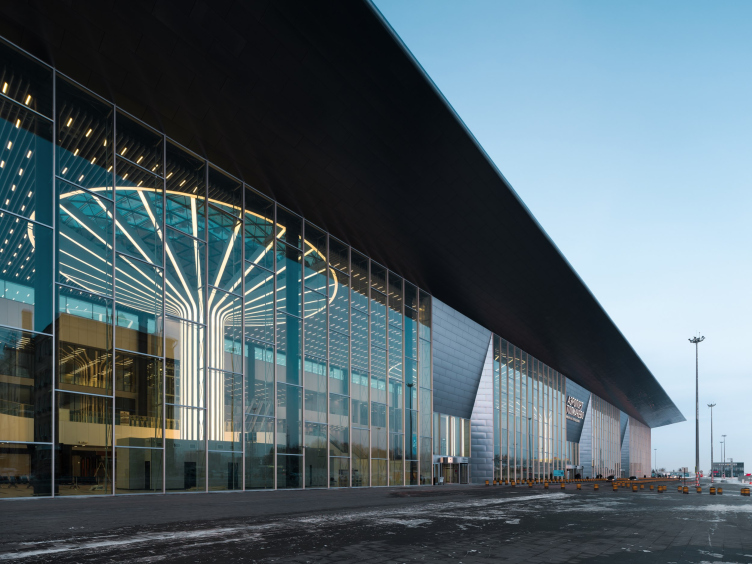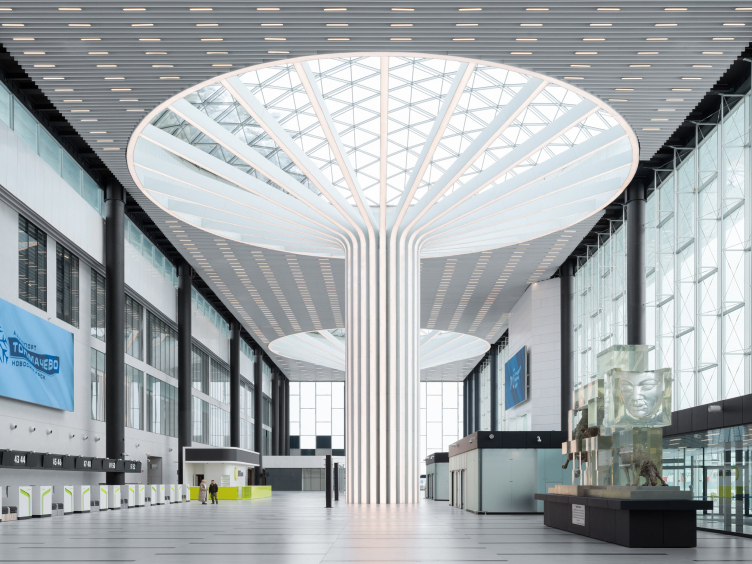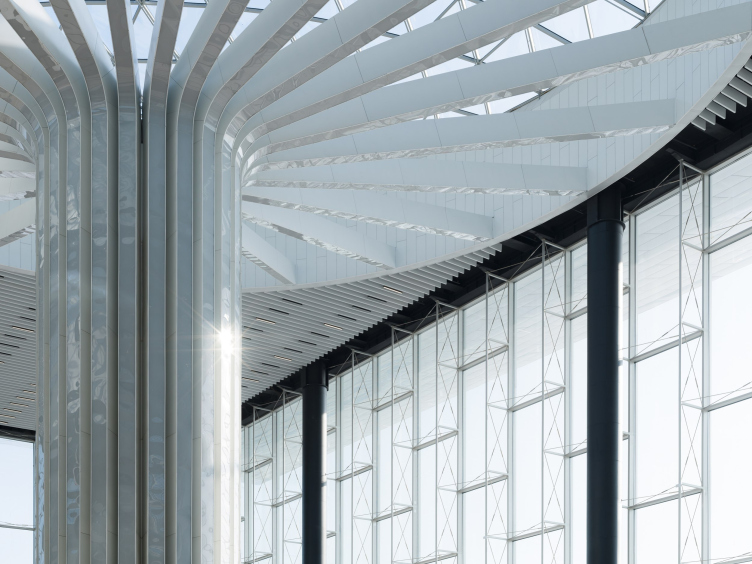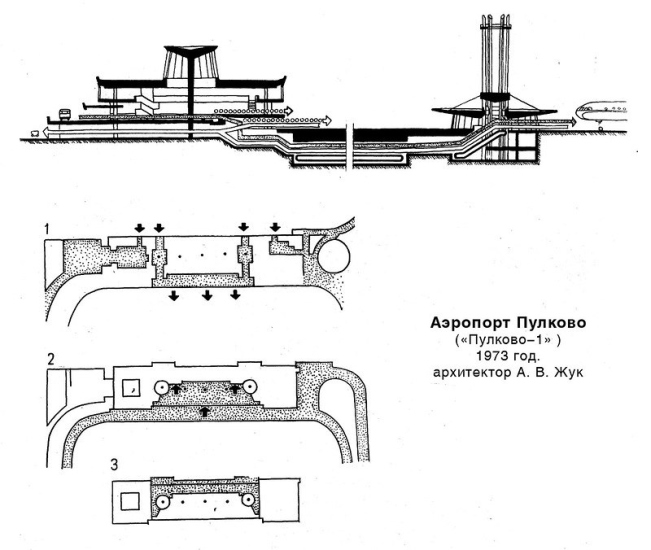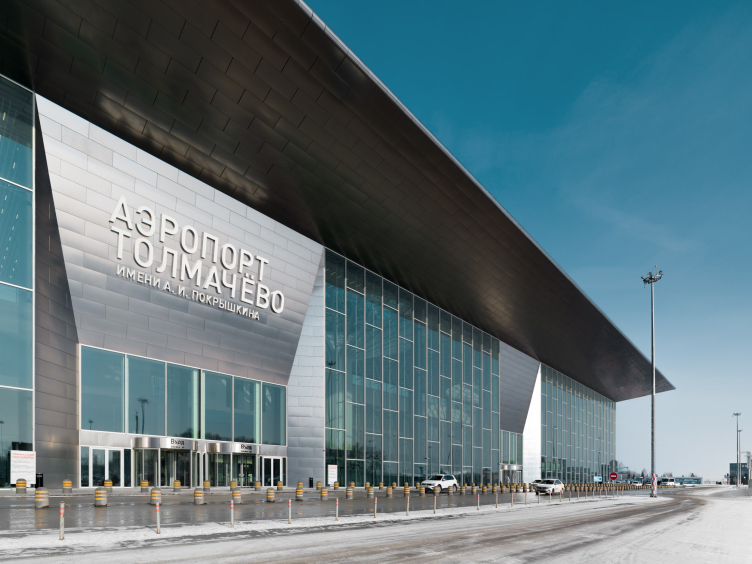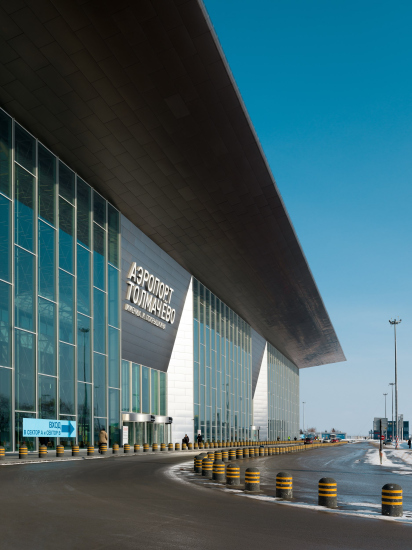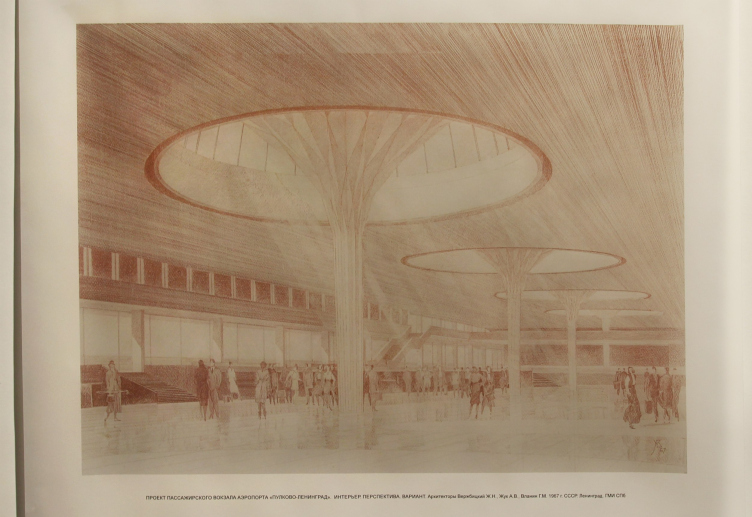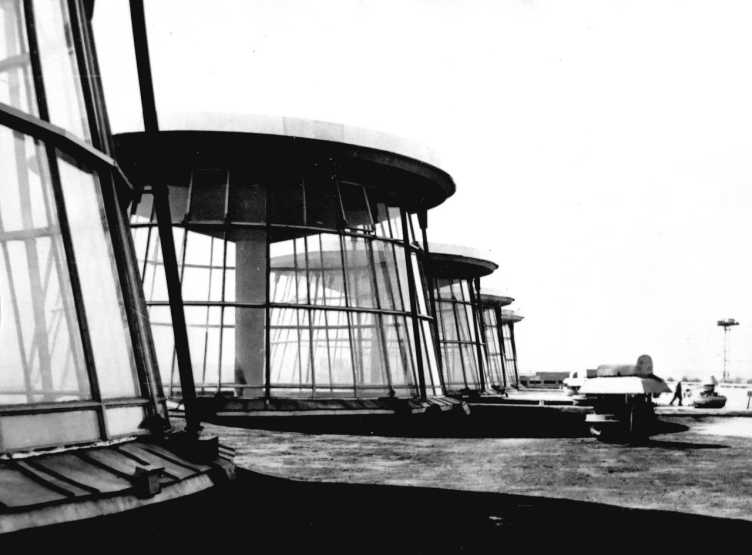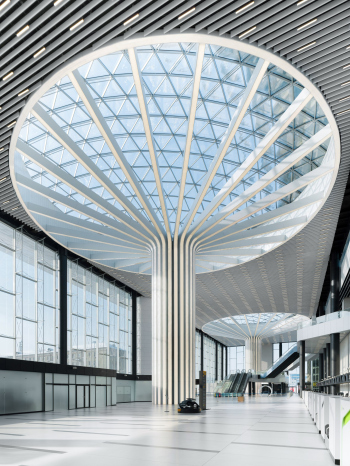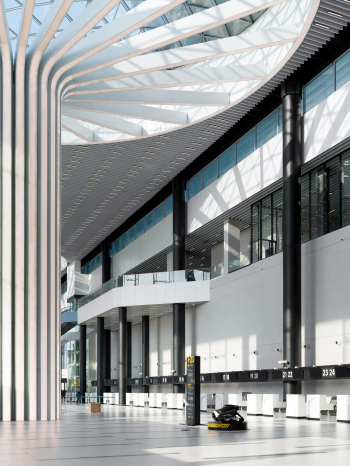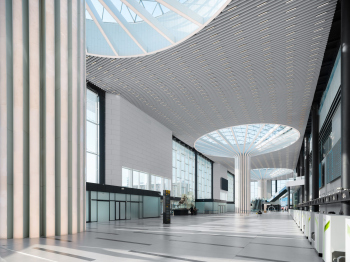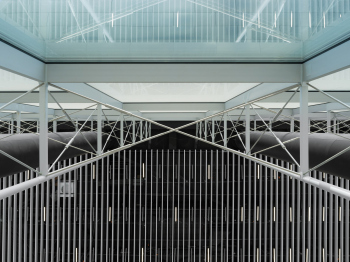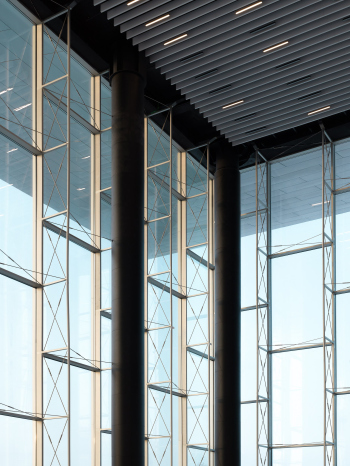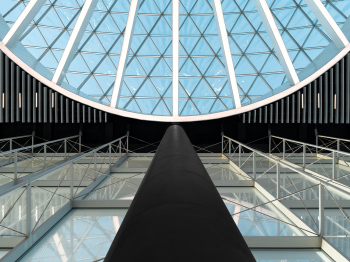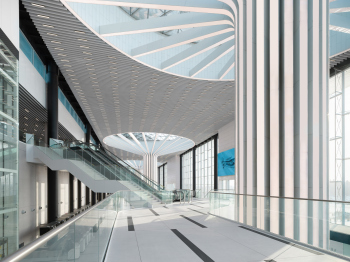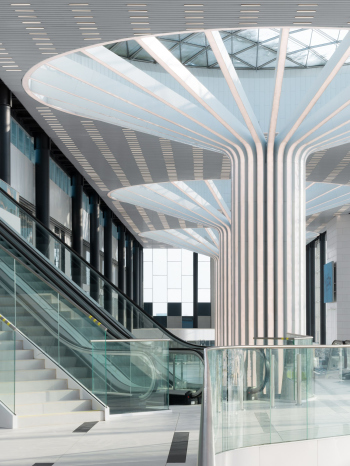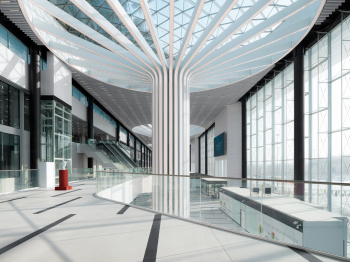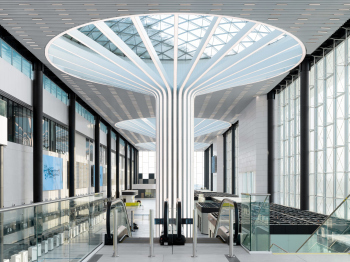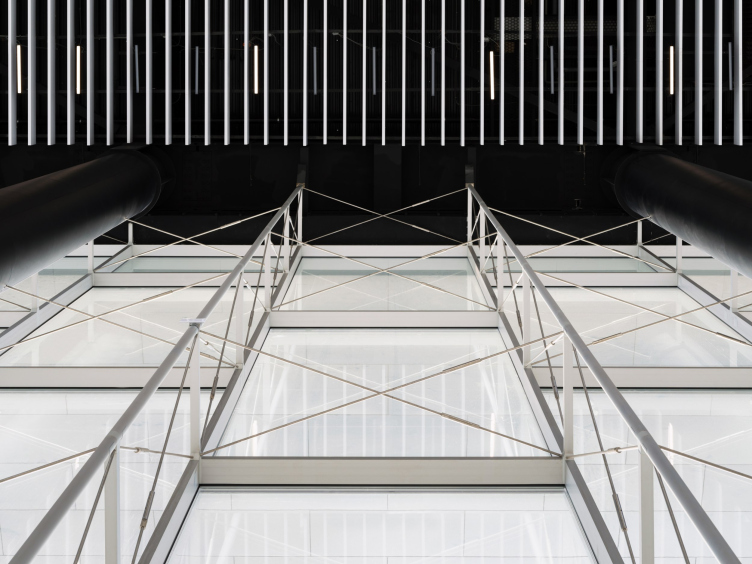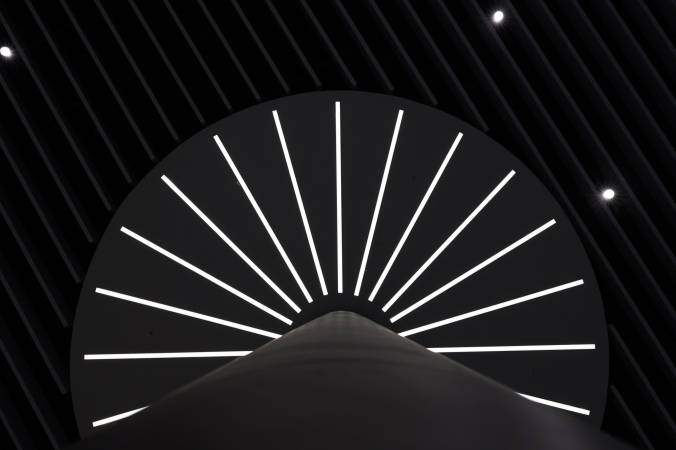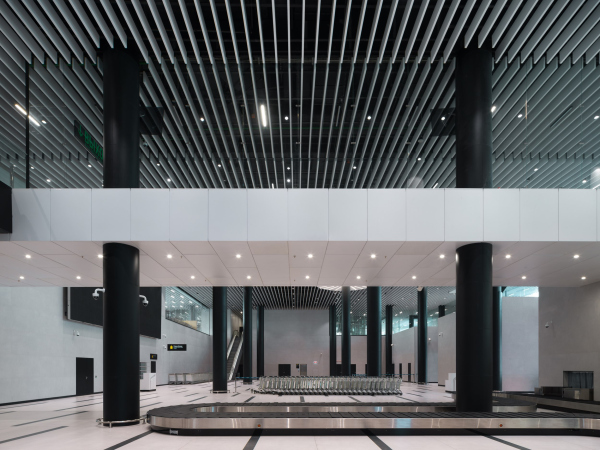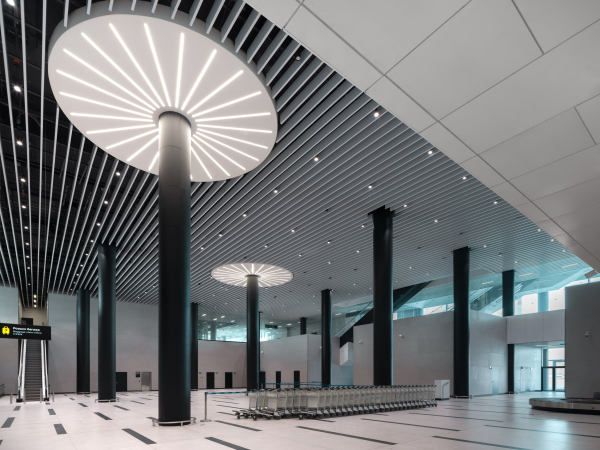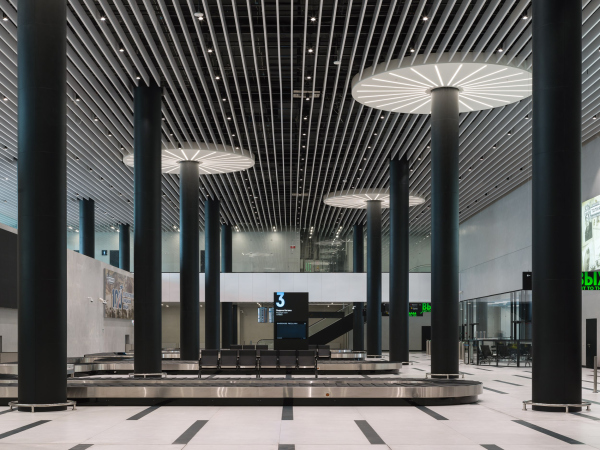Interestingly, both for the head of the architects’ team, Chief Architect of Moscow Sergey Kuznetsov, and for the authors of the architectural solution – Sergey Tchoban and Igor Chlenov – Tolmachevo is the first implemented airport project, although air terminals have appeared in SPEECH’s portfolio before, which makes the result all the more exciting. First things first, however.
Tolmachevo Airport, Terminal C
Copyright: Photograph © Dmitry Chebanenko / provided by SPEECH
The current terminal should become the beginning of the reconstruction of the international airport in Novosibirsk, it is a kind of “first portent”. It is planned to rebuild all the existing buildings in the future. Until the reconstruction is completed, the new Terminal C will work for domestic airlines, while the neighboring Terminal B to the east will continue to function as an international terminal.
Terminal C is located on a new site; it “stepped forward” on the square in front of the existing airport complex, taking on the role of the front facade of Tolmachevo.
There are such projects that are usually represented by numbers; they are usually very noticeable, with a prefix of “mega-“, and Tolmachevo Airport is definitely one of them. The height of the columns is about 30 meters, the diameter of their trunk is 5 m; the diameter of the glass domes is 32 m. The height of the ceiling truss is 1.5 meters. The canopy overhang is 11 meters.
The specifics of the architectural solution, as we know, are affected by scale and size, but not always directly. In this case, the luminous umbrella columns as tall as a nine-story building certainly make an impression.
The columns make an impression when they glow from within through a stained glass window – a giant display case deliberately devoid of additional illumination – like some kind of energy rods.
Tolmachevo Airport, Terminal C
Copyright: Photograph © Dmitry Chebanenko / provided by SPEECH
And they make an impression when the backlighting is off and the columns “bathe” in daylight, abundantly let in by the glass walls on three sides and the domes above.
The columns are amazing: their sheer scale, their “striped” structure, and their position in the space – they seem to occupy the whole of it, but they do not clutter it at all. They are both a part of the building and at the same time an exhibit – a glass cover with an openwork, deliberately thin cable-stayed structure was built for them – in order to show them, which seems quite justified.
Tolmachevo Airport, Terminal C
Copyright: Photograph © Dmitry Chebanenko / provided by SPEECH
Tolmachevo Airport, Terminal C
Copyright: Photograph © Dmitry Chebanenko / provided by SPEECH
Another issue related to the first one has to do with the proportions of the glass “casing”. The length of the glass case is 300 m, width 60 m with the canopy and about 40 m without it. That is, the proportions of the plan inside are practically 1 x 7.5, the front volume being very long.
As for airport terminal buildings in general, they can be almost square or, on the contrary, elongated. The latter is explained by the fact that a long building allows more airplanes to be docked to it. If we look at the plan of St. Petersburg’s Pulkovo, we can see that Grimshaw’s terminal is square, while Alexander Zhuk’s Pulkovo-1 terminal, on the other hand, is long, with not just four but five domes. This is important in this context, because Sergey Tchoban calls Pulkovo-1 the prototype of the Tolmachevo terminal and speaks of intentional parallels with the architecture of “classical” modernism.
Sergey Tchoban
It is now common to design airports with fluid, non-linear forms – it is one of the most expensive, but at the same time quite simple and sure-fire ways to achieve a WOW-effect. However, Novosibirsk is a modernist city, largely developed after the Second World War. We remembered Akademgorodok; and also the very first terminal of the 1960s, designed and built in Tolmachevo by Anatoly Volovik. And we decided to follow the path of restrained architecture, regular and rational, appealing to modernist examples, even though this did not exclude a spectacular gesture, which, in my opinion, were our columns.
For me personally, the key prototype was St. Petersburg’s Pulkovo-1 terminal with its skylights. There, the columns support the roofs at the zeniths of the skylights, and then the roof is suspended from them.
In our case, the design is somewhat different: the columns take on part of the weight of the ceiling trusses, and they share the load with the supports on the outer contour. At the same time, they have a constructive meaning and participate in the distribution of bearing forces inside the building. This was important to us.
For me personally, the key prototype was St. Petersburg’s Pulkovo-1 terminal with its skylights. There, the columns support the roofs at the zeniths of the skylights, and then the roof is suspended from them.
In our case, the design is somewhat different: the columns take on part of the weight of the ceiling trusses, and they share the load with the supports on the outer contour. At the same time, they have a constructive meaning and participate in the distribution of bearing forces inside the building. This was important to us.
-
![Pulkovo-1 airport, interior, 1978. Pulkovo-1 airport, interior, 1978.
Copyright: Zodchestvo (Soviet Architecture). Collection of the Union of Architects of the USSR. vol. 2 (21). 1978 / zooming]()
![Pulkovo-1 Airport, plans and section views Copyright: E.B. Novikova "Interior of Public Buildings (Artistic Problems)". M. Stroyizdat, 1984 / zooming]()
The explanation given here immediately makes the exploration of the prototypes of the airport a fascinating thing to do.
Let’s start with the history of Tolmachevo. The first airport was designed by Novosibgrazhdanproekt back in 1963 as an elongated “beam” building with a square entrance volume of the departure lounge, a stained glass window, and a canopy frame. Here you can see both the project and old photos, and here is the most informative view from above. By 2015, the building was replaced by a new domestic terminal, then it was connected to the glass prisms of the neighboring international terminal, built to the east of it in 1997. The result is a very long and slightly “wiggling” facade, designed in a generalized style, somewhat pretentious and not matching the quality of materials.
In addition to Pulkovo, SPEECH architects cite the example of the House of Scientists in Akademgorodok (1966). However, the format of the new terminal’s glazing can also be compared to another building by Anatoly Volovik in Novosibirsk – the Scientific and Technical Library of the Russian Academy of Sciences (thanks to Marina Ignatushko for the tip).
In Tolmachevo, of course, the glazing is of higher quality: structural, Jumbo, 6 x 3 meters, and with thin vertical slats. However, the image of vertical frames with diagonal alternation and at the same time with slopes, are very much resonant with one another. Quote recognized.
Tolmachevo Airport, Terminal CCopyright: Photograph © Dmitry Chebanenko / provided by SPEECH
Project of the passenger hall of Pulkovo-Leningrad airport. Interior. Perspective. Variant. Architects Verbitsky J.N., Zhuk A.V., Vlanin G.M. 1967. USSR. Leningrad. GMI SPbCopyright: Photographed at the exhibition Architekton 2023
The connection to the main prototype – Pulkovo-1 – is even more intriguing. The Leningrad terminal of 1973 is essentially a long parallelepiped with light skylights supported by columns.
And so, at the recent “Arkhitekton” in St. Petersburg, at an exhibition devoted to Leningrad modernism, an unrealized version of the project caught my eye, where the columns of Pulkovo-1, now rather soaring up into the sky in a somewhat orphaned manner, were drawn mushroom-shaped.
Pulkovo-1 Airport. View on the roof during constructionCopyright: citywalls.ru / загружено ИБН
What is more interesting, however, is that when I asked Sergey Tchoban whether this variant was the inspiration for Tolmachevo, he told me that he did not know about it, and that the first time he ever saw this picture was in the exhibition reports. So the synergy between the project and its prototype, at some immanent level, is even stronger, perhaps, than the author himself could have possibly known? We began to check the projects for similarities, and even little-known variants somehow “fell in line”.
But then again, if you look at the succession of skylights of Pulkovo-1 and at the Tolmachevo hall space as a whole, with your eyes half-closed, they do begin to look similar. The skylights seem to have been brought to some orthogonal projection and merged into one parallelepiped, but the meaning remains: transparent walls, light, supports, umbrellas.
Tolmachevo Airport, Terminal CCopyright: Photograph © Dmitry Chebanenko / provided by SPEECH
It’s not about repetition or quoting, of course, but about being deliberately in line with a certain context.
Mushroom columns are popular in 20th century architecture, and, interestingly, they were used even before modernism: the form dates back to the Neo-Gothic craze that gave the world the fan vault, where the supports merge seamlessly with the ceiling – and at the same time, its development is based on experiments with reinforced concrete technology that only became available a hundred or more years ago. Since then, mushroom-shaped columns, which allow you to free up space and give the ceiling a spectacular plasticity, would be seen here and there. Not to go too far, we can remember yet another project by Sergey Tchoban – the EDGE office building in Berlin, where different-sized wooden “mushrooms”, also plate-like, support the staircases in the atrium space. In that building, by the way, both the shape and the abundance of daylight play a big role, just like they do in Tolmachevo. Airports with similar ideas are also known – for example, in the 2nd terminal of Chhatrapati airport in Mumbai, built according to the SOM project in 2014, mushroom-shaped columns are used, yet of the flexible, mesh-like type. There is no point in talking about borrowings here – rather, we are dealing with a set of ways of organizing large space, common and still perfected in the XX-XXI centuries. In Tolmachevo, the SPEECH architects proposed a version of their own.
Meanwhile, the allusions are not the main thing – they simply add flavor by binding the building with strings of local and other meanings.
And the main thing here, besides brevity, is the abundance of light.
The artificial light of the columns in space is rather akin to some phenomenon of atomic physics, whose dynamics is connected not with the movement accessible to the eye, but with the internal tension of the fields –Akademgorodok, which is located nearby, definitely made its presence known, however indirectly.

And there is plenty of natural light too. A large stained glass window in a modern terminal building is rather a norm, but here we can see it not on just one, but on three sides, and the columns visually “open up” the ceiling, pushing its opaque surface open, revealing the sky in domes. The umbrellas can be compared to the fingers of a hand – only there are a lot of them and they are thin and symmetrical.
In addition, it is important that the building is technologically advanced. The surfaces of the domes, made up of triangles of different formats, and the thin cables of the main stained-glass walls were developed by the company Nesushchie Sistemy (“Bearing Systems”), founded in Novosibirsk and known for having built the first building with non-linear glass facades in the Russian Federation already in 2011, and also for having built the “glass tree bark” of the hall in Zaryadye.
Other technically advanced solutions include the canopy with a large overhang, the ceiling truss, the load distribution between the main “tree” columns and the additional supports that were needed along the glass facades. But there are not many of them, they are tall and thin and not very visible.
Tolmachevo Airport, Terminal CCopyright: Photograph © Dmitry Chebanenko / provided by SPEECH
Meanwhile, there are no “Guinness Book records” here – it’s more about the fact that everything is done at a good level of modern construction: the stretches are thin, the seams of the metal cladding of the portals and the canopy are also thin, they don’t catch the eye, and the steel cassettes themselves are covered with matting varnish so that they shine not too much, but moderately. A certain gentleman’s set of quality, maybe a gloss, not supernatural, but, let’s say, “Metropolitan”. I cannot resist the temptation to say: the way it is supposed to be in the capital of Siberia. After all, after the reconstruction is completed, Tolmachevo will indeed become the largest regional airport.
If the entrance hall is dominated by white color and light – there is an inversion inside. The screening and baggage claim space, as usual, is somewhat simpler and black is either more abundant in it, or it divides the powers with white roughly in half.
Visual “bridges” with the main hall are also provided: round thin fusts of columns remind of supports on the contour, and “daisies” of the lamps embedded in the ceiling unambiguously look like “younger brothers” of the mushroom- shaped columns.
Tolmachevo Airport, Terminal CCopyright: Photograph © Dmitry Chebanenko / provided by SPEECH
However, the most interesting and informative view is from the outside, i.e. from the square. It defines the building’s place in the complex.
It is from here that the whole driving idea can be best appreciated: the luminous “trees”, a kind of Telperions in a casing of transparent and metallic planes. Retrofuturism at its finest: full of meanings, but modern, and WOW-laconic.
It is, in fact, not at all an easy task to make a building both as simple as do-re-mi, and addictively exciting.
Now, wait a minute! Isn’t this a portico?
A giant glowing portico encased in a sheath! Or, perhaps, a stoa, a public gallery from Ancient Greece! It comes forward, forms a representative facade of the airport, declares its ambitions calmly and confidently, marks the entrance not without Hellenistic pathos, as if telling us: I am in charge here, I have been here, in a sense, always. Like the Library of Celsus – whether there is a library or not, the façade is beautiful.
How did it happen? Initially, we were after the simplicity of modernism, but we ended up with a key element of classical architecture?
Well, yes, but not quite. First of all, functionally, the airport entrance hall is a public space for those entering the airport, and it has long since become a place of representation, designed to welcome and impress anyone, to present the airport in all its glory. The portico has the same role, and the row of columns, into which the entrance space has been transformed here, declares this with great magnitude. We are definitely entering somewhere, ready to be transported from Point A to Point B, and the space unequivocally tells us so. Not everyone may understand this but it doesn’t matter; I don’t think everyone understood the meaning of the Library of Celsus either.
Secondly, already in the 1970s, modernism began to search for points of contact with cultural history in the broadest sense, and the main condition of the search was the non-obviousness of the probable quotation, its translation to the level of innuendo. In Tolmachevo, I think we are witnessing a quite successful attempt to return to the same search, as the technology makes its giant leaps.
Which makes the project a really good work with scale and meaning: because when we look closely we see and feel one thing, but when we go outside we see another. However, the most important statement – the almost perfect image of a large airport, the “portico-portal” – is read from afar. It is only then that one realizes that it is about a new beginning.
Firm:SPEECH http://www.speech.su Headlines now“Strangers” in the City We asked Alexander Skokan for a comment on the results of 2025 – and he sent us a whole article, moreover one devoted to the discussion we recently began on the “appropriateness of high-rises” – or, more broadly speaking, “contrasting insertions into the urban fabric”. The result is a text that is essentially a question: why here? Why like this?Dmitry Ostroumov: “To use the language of alchemy, we are involved in the process of “transmutation... What we ended up having was an extremely unusual conversation with Dmitry Ostroumov. Why? At the very least, because he is not just an architect specializing in the construction of Orthodox churches. And not just – which is an extreme rarity – a proponent of developing contemporary stylistics within this still highly conservative field. Dmitry Ostroumov is a Master of Theology. So in addition to the history and specifics of the company, we speak about the very concept of the temple, about canon and tradition, about the living and the eternal, and even about the Russian Logos.MB-PROJECT: “Every new project is a challenge” In this issue, we speak with Dmitry and Oleg Shurygin, founders of the company MV-PROJECT, which has extensive experience in designing theater and entertainment buildings as well as working with cultural heritage sites.A Glazed Figurine In searching for an image for a residential building near the Novodevichy Convent, GAFA architects turned to their own perception of the place: it evoked associations with antiquity, plein-air painting, and vintage artifacts. The two towers will be entirely clad in volumetric glazed ceramic – at present, there are no other buildings like this in Russia. The complex will also stand out thanks to its metabolic bay-window cells, streamlined surfaces, a ceremonial “hotel-style” driveway, and a lobby overlooking a lush garden.A Knight’s Move via the Cour d’Honneur Intercolumnium Architects presented to the City Planning Council a residential complex project that is set to replace the Aquatoria business center on Vyborgskaya Embankment. Experts praised the overall quality of the work, but expressed reservations about the three cour d’honneurs and suggested softening the contrast between the facades facing the embankment and the Kantemirovsky Bridge.A Small Country Mezonproekt is developing a long-term master plan for the MEPhI campus in Obninsk. Over the next ten years, an enclave territory of about 100 hectares, located in a forest on the northern edge of the city, is set to transform into a modern center for the development of the nuclear energy sector. The plan envisions attracting international students and specialists, as well as comprehensive territorial development: both through the contemporary realization of “frozen” plans from the 1980s and through the introduction of new trends – public spaces, an aquapark, a food court, a school, and even a nuclear medicine center. Public and sports facilities are intended to be accessible to city residents as well, and the campus is to be physically and functionally connected to Obninsk.Pearl Divers GAFA has designed an apartment complex for Derbent intended to switch people from a work mode to a resort mindset – and to give the surrounding area a much-needed jolt. The building offers two distinct faces: restrained and laconic on the city side, and a lushly ornate façade facing the sea. At the heart of the complex, a hidden pearl lies – an open-air pool with an arch, offering views of a starry sky, and providing direct access to the beach.A Satellite Island The Genplan Institute of Moscow has prepared a master plan for the development of the Sarpinsky and Golodny island system, located within the administrative boundaries of Volgograd and considered among the largest river islands in Russia. By 2045, the plan envisions the implementation of 15 large-scale investment projects, including sports and educational clusters, a congress center with a “Volgonarium”, a film production cluster, and twenty-one theme parks. We explain which engineering, environmental, and transportation challenges must be addressed to turn this vision into reality. The master plan solutions have already been approved and incorporated into the city’s general development plan.The Amber Gate The Amber City residential complex is one of the redevelopment projects in the former industrial area located beyond Moscow’s Third Ring Road near Begovaya metro station. Alexey Ilyin’s studio proposed an original master plan that transformed two clusters of towers into ceremonial propylaea, gave the complex a recognizable silhouette, and established visual connections with new high-rise developments on both right and left – thus integrating it into the scale of the growing metropolis. It is also marked by its own futuristic stylistic language, based on a reinterpreted streamline aesthetic.A Theater Triangle The architectural company “Chetvertoe Izmerenie” (“Fourth Dimension”) has developed the design for a new stage of the Magnitogorsk Musical Theater, rethinking not only theater architecture but also the role of the theater in the contemporary city.Aleksei Ilyin: “I approach every task with genuine interest” Aleksei Ilyin has been working on major urban projects for more than 30 years. He has all the necessary skills for high-rise construction in Moscow – yet he believes it’s essential to maintain variety in the typologies and scales represented in his portfolio. He is passionate about drawing – but only from life, and also in the process of working on a project. We talk about the structure and optimal size of an office, about his past and current projects, large and small tasks, and about creative priorities.Sergey Tchoban: “My ideal model for shaping a museum space is the Uffizi Gallery. In the... Yesterday, the ZILART Museum opened on the ZILART grounds with three exhibitions curated by well-known curators. We speak with Sergey Tchoban about the concept and its realization.A Golden Sunbeam A compact brick-and-metal building in the growing Shukhov Park in Vyksa seems to absorb sunlight, transform it into yellow accents inside, and in the evening “give it back” as a warm golden glow streaming from its windows. It is, frankly, a very attractive building: both material and lightweight at the same time, with lightness inside and materiality outside. Its form is shaped by function – laconic, yet far from simple. Let’s take a closer look.Architecton Awards In 2025, the jury of the Architecton festival reviewed the finalist projects through live, open presentations held right in the exhibition hall – a rather engaging performance, and something rarely seen among Russian awards. It would be great if “Zodchestvo” adopted this format. Below, we present all the winning projects, including four special nominations.Garden of Knowledge UNK architects and UNK design created the interiors of the Letovo Junior campus, working together with NF Studio, which was responsible for developing the educational technology that takes into account the needs and perception of younger and middle school children.The Silver Skates The STONE Kaluzhskaya office quarter is accompanied by two residential towers, making the complex – for it is indeed a single ensemble – well balanced in functional terms. The architects at Kleinewelt gave the residential buildings a silvery finish to match the office blocks. How they are similar, how they differ, and what “Silver Skates” has to do with it – we explore in this article.On the Dynastic Trail The houses and townhouses of the “Tsarskaya Tropа” (“Czar’s Trail”) complex are being built in the village of Gaspra in Crimea – to the west and east of the palaces of the former grand-ducal residence “Ai-Todor”. One of the main challenges for the architects at KPLN, who developed the project, was to respond appropriately to this significant neighboring heritage. How this influenced the massing, the façades, and the way the authors work with the terrain is explored in our article.A New Path The main feature of the Yar Park project, designed by Sergey Skuratov for Kazan, is that it is organized along the “spine” of a multifunctional mall with an impressive multi-height atrium space in its middle. The entire site, both on the city side and the Kazanka River embankment, is open to the public. The complex is intended not to become “yet another fenced enclave” but, as urban planners say, a “polycenter” – a new point of attraction for the whole of Kazan, especially its northern part, made up of residential districts that until now have lacked such a vibrant public space. It represents a new urban planning approach to a high-density mixed-use development situated in the city center – in a sense, an “anti-quarter”. Even Moscow, one might say, doesn’t yet have anything quite like it. Well, lucky Kazan!Beneath the Azure Sky A depository designed by Studio 44 will soon be built in Kenozersky National Park to preserve and display the so-called “heavens” – ceiling structures characteristic of wooden churches in the Russian North, painted with biblical scenes. For each of these “heavens”, the architects created a volume corresponding in scale and dimensions to the original church interior. The result is a honeycomb-like composition, with modules derived directly from the historic monuments themselves, allowing visitors to view the icons from the historically accurate angle – from below, looking upward. How exactly this works is the subject of our story.The Power of Lines The building at the very beginning of New Arbat is the result of long deliberations over how to replace the former House of Communication. Contemporary, dynamic, and even somewhat zoomorphic in character, it is structured around a large diagonal grid. The building has become a striking accent both in the perspective of the former Kalinin Avenue and in the panorama of Arbat Square. Yet, unfortunately, the original concept was not fully realized. In 2020, the Moscow ArchCouncil approved a design featuring an exoskeleton – an external load-bearing structure, which eventually turned into a purely decorative element. Still, the power of the supergraphic “holds” the building, giving it the qualities of a new urban landmark with iconic potential. How this concept took shape, what unexpected associations might underlie the grid’s form, and why the exoskeleton was never built – all this is explored in our article.Resort on the Kama River Wowhaus has developed a project for the reconstruction of Korabelnaya Roshcha (“Mast Grove”), a wellness resort located on the banks of the Kama River.Nests in Primorye The eco-park project “Nests”, designed by Aleksey Polishchuk and the company Power Technologies, received first prize at the Eco-Coast 2025 festival, organized by the Union of Architects of Russia. For a glamping site in Filinskaya Bay, the authors proposed bird-shaped houses, treehouses, and a nest-shaped observation platform, topping it all with an entrance pavilion executed in the shape of an owl.The Angle of String Tension The House of Music, designed by Vladimir Plotkin and the architects of TPO Reserve, resembles a harp, and when seen from above, even a bass clef. But if only it were that simple! The architecture of the complex fuses two distinct expressive languages: the lattice-like, transparent, permeable vocabulary of “classical” modernism and the sculptural, ribbon-like volumes so beloved by today’s neo-modernism. How it all works – where the catharsis lies, which compositional axes underpin the design, where the project resembles Zaryadye Concert Hall and where it does not – read in the article below.How Historic Tobolsk Becomes a Portal to the Future Over the past decade, the architectural company Wowhaus has developed urban strategies for several Russian cities – Vyksa, Tula, and Nizhnekamsk, to name but a few. Against this backdrop, the Tobolsk master plan stands out both for its scale – the territory under transformation covers more than 220 square kilometers – and for its complexity.St. Petersburg vs Rome The center of St. Petersburg is, as we know, sacred – but few people can say with certainty where this “sacred place” actually begins and ends. It’s not about the formal boundaries, “from the Obvodny Canal to the Bolshaya Nevka”, but about the vibe that feels true to the city center. With the Nevskaya Ratusha complex – built to a design that won an international competition – Evgeny Gerasimov and Sergei Tchoban created an “image of the center” within its territory. And not so much the image of St. Petersburg itself, as that of a global metropolis. This is something new, something that hasn’t appeared in the city for a long time. In this article, we study the atmosphere, recall precedents, and even reflect on who and when first called St. Petersburg the “new Rome”. Clearly, the idea is alive for a reason.On the Wave The project of transforming the river port and embankment in the city of Cheboksary, developed by the ATRIUM Architects, involves one of the city’s key areas. The Volga embankment is to be turned into a riverside boulevard – a multifunctional, comfortable, and expressive space for work and leisure activities. The authors propose creating a new link with the city’s main Krasnaya (“Red”) Square, as well as erecting several residential towers inspired by the shape of the traditional national women’s headdress – these towers are likely to become striking accents on the Volga panorama.Valery Kanyashin: “We Were Given a Free Hand” The Headliner residential complex, the main part of which was recently completed just across from Moscow City, is a kind of neighbor to the MIBC that doesn’t “play along” with it. On the contrary, the new complex is entirely built on contrast: like a city of differently scaled buildings that seems to have emerged naturally over the past 20 years – which is a hugely popular trend nowadays! And yet here – perhaps only here – such a project has been realized to its full potential. Yes, high-rises dominate, but all these slender, delicate profiles, all these exciting perspectives! And most importantly – how everything is mixed and composed together... We spoke with the project’s leader Valery Kanyashin.The Keystone Until quite recently, premium residential and office complexes in Moscow were seen as the exclusive privilege of the city center. Today the situation is changing: high-quality architecture is moving beyond the confines of the Third Ring Road and appearing on the outskirts. The STONE Kaluzhskaya business center is one such example. Projects like this help decentralize the megalopolis, making life and work prestigious in any part of the city.Perpetuum Mobile The interior of the headquarters of Natsproektstroy, created by the IND studio team, vividly and effectively reflects the client’s field of activity – it is one of Russia’s largest infrastructure companies, responsible for logistics and transport communications of every kind you can possibly think of.Water and Light Church art is full of symbolism, and part of it is truly canonical, while another part is shaped by tradition and is perceived by some as obligatory. Because of this kind of “false conservatism”, contemporary church architecture develops slowly compared to other genres, and rarely looks contemporary. Nevertheless, there are enthusiasts in this field out there: the cemetery church of Archangel Michael in Apatity, designed by Dmitry Ostroumov and Prokhram bureau, combines tradition and experiment. This is not an experiment for its own sake, however – rather, the considered work of a contemporary architect with the symbolism of space, volume, and, above all, light.

